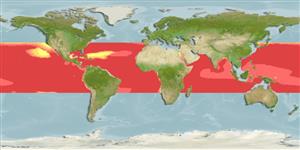Teleostei (teleosts) >
Argentiniformes (Marine smelts) >
Bathylagidae (Deep-sea smelts)
Etymology: Dolicholagus: Greek, dolichos = long + Greek, lagos = hare (Ref. 45335).
Issue
Genus in Ref. 9875.
Environment: milieu / climate zone / depth range / distribution range
Ecology
Marine; bathypelagic; depth range 200 - 1497 m (Ref. 27311), usually 200 - 400 m (Ref. 33679). Deep-water; 39°N - 21°S
Widely distributed in tropical and subtropical seas. Eastern Atlantic: south of Portugal to Madeira. Western Atlantic: Gulf of Mexico (Ref. 27768). Northwest Atlantic: Canada (Ref. 5951). Northwest Pacific: Japan (Ref. 559). Southwest Pacific: New Zealand (Ref. 5755). Eastern Pacific: California Current region (Ref. 35604).
Size / Weight / Age
Maturity: Lm ? range ? - ? cm
Max length : 17.5 cm SL male/unsexed; (Ref. 4459)
Dorsal spines (total): 0; Dorsal soft rays (total): 9 - 11; Anal spines: 0; Anal soft rays: 18 - 21; Vertebrae: 48 - 53. Head and body silver when fresh; no scale pocket markings; lateral line indistinct (Ref. 13608). Slender body. Jaws rounded and subequal at the tips (Ref. 37473). Body strongly elongated with almost equal depth. Caudal peduncle short and relatively narrow. Pectorals short, far from reaching origin of dorsal fin. Radial pattern noticeable at the hind lower part of operculum. Few gill rakers on the inner surface of epibranchial of first gill arch (Ref. 33679).
Mesopelagic (Ref. 58302). Usually caught in small aggregations (Ref. 6345). Exhibits daily vertical migrations (Ref. 6345). Feeds on plankton (Ref. 6345).
Life cycle and mating behavior
Maturity | Reproduction | Spawning | Eggs | Fecundity | Larvae
Cohen, D.M., 1990. Bathylagidae. p. 239-240. In J.C. Quero, J.C. Hureau, C. Karrer, A. Post and L. Saldanha (eds.) Check-list of the fishes of the eastern tropical Atlantic (CLOFETA). JNICT, Lisbon; SEI, Paris; and UNESCO, Paris. Vol. 1. (Ref. 4459)
IUCN Red List Status (Ref. 130435: Version 2024-2)
Threat to humans
Harmless
Human uses
Fisheries: of no interest
Tools
Special reports
Download XML
Internet sources
Estimates based on models
Preferred temperature (Ref.
123201): 8.8 - 19, mean 13 °C (based on 406 cells).
Phylogenetic diversity index (Ref.
82804): PD
50 = 1.0000 [Uniqueness, from 0.5 = low to 2.0 = high].
Bayesian length-weight: a=0.00525 (0.00219 - 0.01260), b=3.01 (2.80 - 3.22), in cm total length, based on LWR estimates for this (Sub)family-body shape (Ref.
93245).
Trophic level (Ref.
69278): 3.4 ±0.45 se; based on food items.
Resilience (Ref.
120179): Medium, minimum population doubling time 1.4 - 4.4 years (Preliminary K or Fecundity.).
Fishing Vulnerability (Ref.
59153): Low vulnerability (11 of 100).
